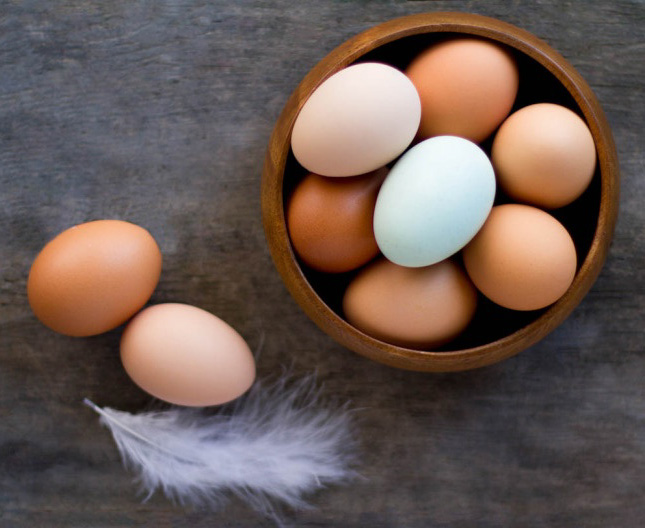
Eggs. Should seem simple, right? But these days, with all the marketing gobbledygook to sift through, it can take a mini-handbook just to figure out what you’re buying.
Today, between 95-98% of eggs sold in the United States are from battery cage hens. These poor hens spend their entire lives, crammed 4-5 hens to a cage, living in a space that is smaller than a letter-sized piece of paper. The poor things can’t even grow proper feathers. How can an egg produced by a sick bird be good for you to eat?
Learn the Terminology
“FARM FRESH” or “ALL-NATURAL”: These words are meaningless when it comes to knowing the living conditions of the hens, how they were treated, and what they ate.
“CAGE FREE”: All this means is that the hens are not in cages, but it does not guarantee that they have access to the outdoors or even sunlight. While un-caged, it does not mean that they are unconfined. Many birds are still housed in long, dark chicken sheds, with henhouses containing as many as 36,000 birds in a single shed.
“OMEGA-3 ENHANCED”: This means that the hens were given feed that contained omega-3s, usually in the form of flaxseed. The eggs are unregulated, and the hens can still be living in battery cages. Pastured eggs have naturally occurring omega-3s, so why “enhance” or “fortify” the eggs unless they are of lower quality to begin with? (And not to go off on a tangent, but it’s the same thing with milk that’s fortified with vitamins A and D. Real, raw milk has naturally occurring and easily absorbable vitamins A and D. Only dead milk needs to be “fortified.” Anyway, moving on!)
“FREE-RANGE”: This simply means that the hens are supposed to be given access to the outside, but it does not specify how much access or how long.
“ORGANIC”: Organic eggs come from hens that are raised without hormones or antibiotics, are fed organic feed, and have access to the outside. Again, the “access” is not regulated, and could mean anything. Many producers in the egg industry have easily converted cage-free henhouses to “organic” by simply building a small porch off of a long shed and feeding the birds organic feed. So on paper they are “organic,” but it does not mean they adhere to the “organic” principles you or I would like to think more highly of. So if it matters to you that your birds see the light of day, you’ll need to do some research about your individual egg producer.
“PASTURED”: I feel like this term is even more loosely regulated than organic. A pastured bird simply means it is on pasture. But it does not mean the birds aren’t given hormones or antibiotics, and it does not mean that they also aren’t receiving feed. Chickens are naturally omnivores, so they require protein, which most farmers provide in the form of feed.
I’m NOT saying that you shouldn’t buy pastured eggs. Pastured eggs are still the best choice if the chickens aren’t consuming GMOs.
BUT BEWARE…
Some egg suppliers use GMO feed for their chickens, even pastured birds. This is due to the large cost for feed. GMO is simply cheaper. I’ve talked with a few farmers, and they’ve said that if they do all organic pastured birds, to make any money for their labor, they’d have to sell a dozen eggs at $6. But most people simply won’t pay $6 for eggs.
Frank and I recently visited a farm that claimed to be “just as good as organic” and raised pastured birds. However, over 70% of the birds’ diets were GMO feed. So keep in mind that “pastured” does not necessarily mean the hens and the eggs are healthier—although, it’s certainly a start.
Be sure to always ask what kind of protein or feed your egg supplier uses to supplement the birds’ diet.











Great piece here! And this is why we raise our own laying hens and pay the extra for non-GMO, organic feed (and it IS considerably higher than “regular” feed). So incredibly worth it to know what’s actually going in to the chickens, into the eggs, and into our bodies!
Or get chickens for your own backyard! ♥